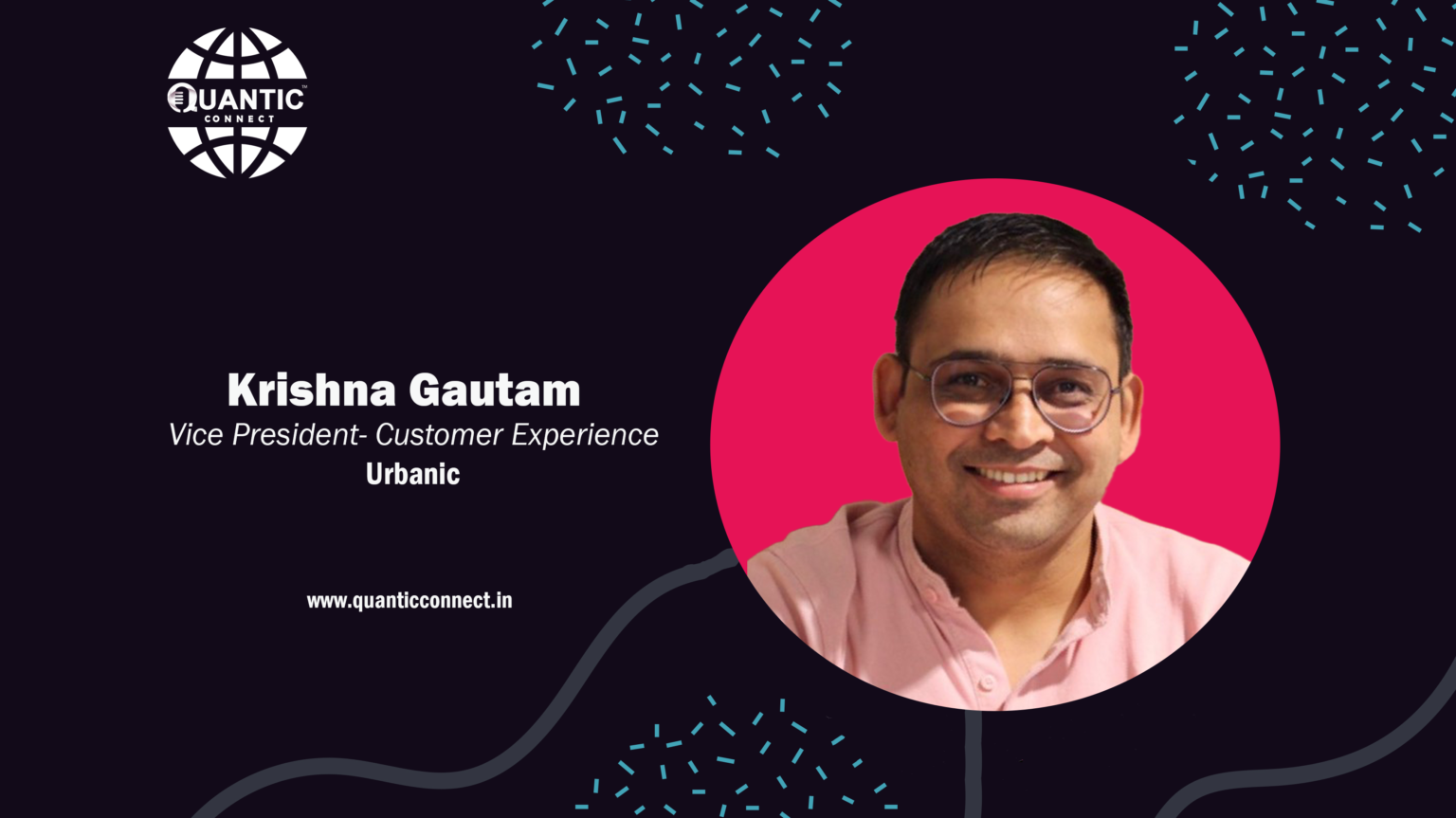New Delhi, February 06: Customer Experience in the retail industry encompasses the holistic journey of shoppers, from initial engagement to post-purchase interactions. It focuses on creating seamless, personalized, and memorable encounters at every touch point, aiming to exceed customer expectations and foster loyalty. By understanding and catering to consumer preferences, behaviours, and needs, retailers enhance satisfaction, drive sales, and build enduring relationships, thereby distinguishing themselves in today’s competitive market landscape.
Join Mr. Krishna Gautam who is the Vice President- Customer Experience at Urbanic in conversation with Mr. Marquis Fernandes who spearheads the India Business at Quantic India, as they delve into critical role of data-driven decision-making in enhancing customer satisfaction and operational efficiency. By leveraging various data sources and customer feedback mechanisms, initiatives such as implementing chatbots for basic inquiries, optimizing the returns process, and automating refunds. These strategies not only streamline operations but also significantly improve the overall customer experience, highlighting the importance of innovation, collaboration, and continuous improvement in the Customer Experience domain.
Mr. Krishna Gautam is a seasoned customer-centric leader with over 15 years of expertise in customer support and experience. His passion lies in delivering exceptional customer experiences, while fostering lasting relationships and enhancing employee engagement. With a strong focus on data-driven decision-making and people-centric leadership, Krishna is a dedicated advocate for digital transformation, operations planning, and continuous improvement in customer experience.
As a data-driven decision-maker, how do you leverage data insights to guide strategic decision-making in enhancing customer satisfaction and optimizing operational efficiency?
In today’s fast-paced business environment, marked by uncertainties and an ever-growing list of tasks aimed at enhancing user experience and business growth, it is essential that every decision is grounded in solid data. This approach ensures the optimal and effective use of resources. Given our limited resources, it is crucial to invest in areas that genuinely resonate with our users and significantly enhance their experience. Therefore, basing decisions on data is imperative to address the most relevant issues and make impactful improvements in user experience.
Our strategy embraces a data-driven approach, gathering insights through various methods such as direct user feedback, in-person meetings, surveys, Net Promoter Score (NPS) feedback, analysis of online behaviour, and social media engagement. For us, data analysis extends beyond mere numbers; it involves delving into the sentiments and experiences underlying the data. This means actively listening to our customers, which not only informs us of their expectations but also helps us maintain a closer connection with them. This approach allows us to gauge their feelings about our brand, identify our strengths, pinpoint areas for improvement, determine priorities, and decide what can be deferred.
This methodology has been integral in aligning our product roadmap and strategic initiatives with customer expectations, keeping their experience at the forefront. For instance, we identified a common issue among many users regarding finding the correct size fit in certain categories. To address this, we developed a solution allowing users to receive personalized size recommendations based on a few measurements provided once in their profile section. This one-time activity ensures accurate size suggestions for all future purchases. We prioritized privacy in this solution, employing AI and machine learning algorithms to eliminate the need for human intervention and secure the data provided by users.
Such projects, driven by thorough data analysis and customer feedback, have been fundamental in our ongoing efforts to enhance user experience and business growth.
Could you share a notable instance where you successfully implemented CX automation, and what impact did it have on improving overall customer experience?
A few months ago, we noticed that a large volume of customer inquiries revolved around basic questions: order tracking, return policies, and product availability. While these are important queries, answering them was consuming a significant amount of our customer service team’s time, which could have been used to handle more complex customer issues.
To address this, we decided to implement a chatbot on our website and mobile app. This chatbot was designed to handle these basic inquiries through natural language processing and machine learning algorithms. It could provide instant responses to common questions, guide customers through general questions, and even assist with tracking orders.
The impact was remarkable. Firstly, it led to an immediate increase in customer satisfaction scores. Customers appreciated the instant responses, especially outside of regular business hours. The chatbot also had a feature to escalate more complex issues to a human agent, ensuring that customers always had access to the level of support they needed.
From an operational perspective, this automation significantly reduced the workload on our customer service team. They could now focus on more complex and high-value interactions, such as handling returns that required a more personal touch or resolving unique customer issues. This not only improved their job satisfaction but also increased the efficiency and effectiveness of our customer service operations.
Moreover, the chatbot collected valuable data from interactions, which provided insights into common customer concerns and preferences. This data was used to improve our FAQs, product descriptions, and even informed some of our product development decisions.
In conclusion, the implementation of CX automation through our chatbot was a pivotal step in enhancing our overall customer experience. It improved the efficiency of our customer service, provided valuable insights, and most importantly, made it easier and more enjoyable for customers to interact with our brand.
Your expertise extends to various areas, including NPS, CSAT, people management, and product management. Can you elaborate on a specific project where you effectively utilized these skills to drive success?
One of the projects we undertook was improving our returns process. We started this project after realizing, through our customer feedback data, that people were unhappy with the long wait for refunds caused by slow quality checks at our warehouse. Our innovative solution was to check the quality of returned items right at the customer’s doorstep.
With this new method, our delivery team would check the items when they picked them up from the customer. This not only sped up the refund process but also made it more transparent. Customers could see the quality check happening, which helped them trust and feel more satisfied with our brand. The biggest change was how quickly we could process refunds: what used to take several days now often happened within 30 minutes of pickup.
Putting this plan into action had its challenges. We had to align on various aspects of the QC, which were not present in the current logistic eco system, with our logistics partners to do quality checks efficiently, and we updated our return policies to include this new step. We also made sure to communicate these changes clearly to our customers.
The results were impressive. Our customer satisfaction scores improved a lot, especially regarding returns and refunds. Customers liked how fast and open the process was, which improved their experience and made them more loyal to our brand. This project really shows how listening to customers and coming up with creative solutions can turn a big challenge into a great opportunity to make things better for our customers and our business.
Can you provide insights into a successful digital transformation initiative you spearheaded to enhance customer experiences?
We undertook a project to make our refund process more efficient, responding directly to what we learned from customer feedback. We found that a major issue was delays in refunds, often due to customers entering incorrect bank details. This led to a lot of manual work to fix these errors and process the refunds, which was frustrating for customers and negatively impacted their perception of our brand.
To tackle this, we focused on automating the refund process to eliminate errors. We collaborated with our payment partners to develop a digital solution that could instantly verify bank account information. This meant implementing a system where a small amount would be deposited into the customer’s bank account. If this deposit was successful, the customer could proceed with their return request. If not, the system would alert them to the incorrect bank details and prompt them to make corrections.
This approach made a significant impact. It reduced mistakes in bank details, speeding up the refund process. Customers appreciated how fast and straightforward it was, a satisfaction reflected in our improved customer satisfaction scores. This project not only enhanced our customers’ experience but also eased the workload for our customer service team, boosting the overall efficiency of our refund process.
In essence, by addressing a specific challenge highlighted by customer feedback with a clever solution, we significantly enhanced customer satisfaction and operational efficiency. This project demonstrated our commitment to continually evolve our processes to not just meet, but exceed, our customers’ expectations.
Given your dedication to creating a nurturing work environment, how do you encourage collaboration, growth, and innovation among your team members?
I’m dedicated to creating a supportive and thriving work environment, guided by several fundamental principles. First and foremost, I avoid micromanaging. Experience has shown me that too much oversight can dampen creativity and individuality. Instead, I provide my team with the freedom to explore and devise their own solutions to problems. This autonomy not only sharpens their problem-solving skills but also inspires them to tackle challenges with innovative thinking.
When leading my team, my role is to set the direction for tasks and then step back, allowing them to lead their own way. They work independently, but with the reassurance that support and advice are available whenever needed. This method encourages a variety of viewpoints and instils a strong sense of ownership among team members. It’s always impressive to witness the range of ideas and solutions that come about when people have the liberty to think and act on their own.
Another key element of our workplace culture is our focus on internal promotion. We’re committed to developing our team’s talents and providing them with opportunities to advance within the organization. This not only enables individual growth parallel to the company’s growth but also acts as a significant incentive for the whole team. Seeing tangible examples of advancement within their own ranks bolsters their dedication and hard work.
To sum up, my approach to nurturing a positive work environment centres on a mix of guidance and independence, encouraging inventive problem-solving, and creating clear opportunities for personal and professional growth. This leads to a dynamic, enthusiastic team ready to innovate and embrace new challenges.
What key advice or message would you offer to aspiring individuals in this Customer Experience domain?
Certainly! If I were to offer advice to individuals aspiring to excel in the Customer Experience (CX) domain, it would centre on a few key principles. First and foremost, it’s crucial to deeply understand your customers. This involves not just looking at data and trends but truly empathizing with their needs and experiences. Continuous learning is also vital in this field; the CX landscape is always evolving, so staying abreast of new trends and technologies is key.
However, it’s important to balance this data-driven approach with human insights. Sometimes the numbers don’t tell the whole story, and you need to listen to what customers are really saying. This ties into fostering a customer-centric culture throughout the organization. CX isn’t confined to one department; it’s a mindset that should permeate every aspect of the business.
Innovation and experimentation are also essential. Don’t be afraid to try new things and learn from both successes and failures. Collaborating across departments is crucial too, as delivering a seamless customer experience is a team effort.
Effective communication skills are another cornerstone. Whether it’s interacting with customers or advocating for their needs within your organization, being able to clearly and persuasively convey ideas is crucial.
And, of course, measuring the impact of your strategies is key. Use metrics like NPS and CSAT to gauge success and continuously iterate based on this feedback. Lastly, never underestimate the power of empathy and patience in every interaction. Understanding and addressing customer needs often requires a thoughtful and patient approach. In summary, excelling in CX is about combining data-driven insights with empathy, creativity, and a commitment to continuous learning and improvement.
To know more about us / publish your article, reach us at
www.quanticindia.com
marquis@quanticindia.com.



